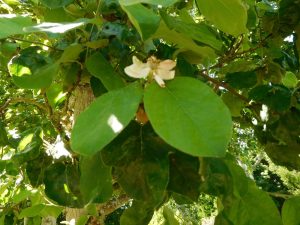
A wise gardener many years ago told me that every year she tries something new. This philosophy has become an inspiration in my own garden. At the same time, she gave me a bareroot ‘Red Lake’ Currant (Ribes rubrum). I wasn’t as familiar with currants, as I am now, so it was a fun trial. I was happy to learn they are self-fertile. My red currant has a long history of being moved around in a container and has done very well. Typically, they are best suited planted in the ground but I can certainly attest these are resilient plants. Every few years I do re-pot and check the roots to make sure it isn’t root bound and it still has good drainage. I am conscientious about pruning so it doesn’t become overgrown. Ribes rubrum ‘Red Lake’ is an abundant producing variety. Red currants have tiny berries that are delicious but tart, which in my opinion, make them perfect for adding into smoothies or baked goods. Mine has been very productive, generally I get several pints a year from it.

Everything about Pawpaws (Asimina triloba) says tropical from leaf size and shape to fruit yet, they are actually cold hardy to -20 degrees so these grow very well in the Pacific Northwest. Pawpaws are truly unique with a sweet banana-like flavor which is nutritious and delicious. Just be sure to purchase two different varieties for pollination. This plant is also said to be deer resistant although, you may want a cage around it in the initial stages of growth. A staple in Native American diets, this was one of the largest fruits growing to 3-6”. The foliage is even a striking bright yellow in the fall. Each tree can yield up to 30 pounds of fruit!
I’ve also known several people growing Quince (Cydonia oblonga) trees. ‘Mellow’ Quince is an abundant producing tree that has bright yellow, crisp yet juicy fruit. I had a neighbor who absolutely loved making a traditional “quince cheese” also known as membrillo, quince paste from this tree. This sweet, thick jelly is served in many countries for its enticing lemon-like flavor. ‘Mellow’ Quince is also dwarf variety that stays reasonable at 8-10ft and is self-fertile. However, you will have a better crop if cross-pollinated with another tree.

Is there anything better than fresh fruit in the late fall, or even December?! Kiwi has been on my garden dream list. I have only hesitated due to lack of space. I’ve always envisioned walking through a wrought iron trellis during the autumn months snacking on delicious fruit. These plants are vigorous growers, so be sure to provide a sturdy trellis for them. Also be sure to plant a male and female for pollination. The good news is one male can pollinate up to 6 females!

The possibilities are endless- so I ask you to challenge yourself. Stop into our Corner Store Nursery and let’s talk fruit! We have something for every yard from large fruit trees Persimmons, Peaches, Nectarines and Apricots to fruits that can be grown in a container.
Written by Karen Smith, Lane Forest Products Plant Specialist
